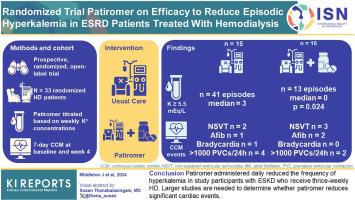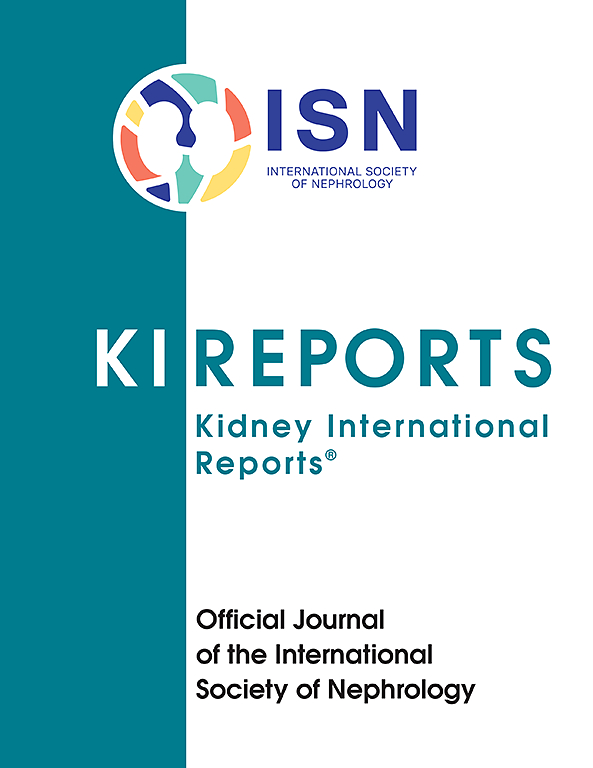Randomized Trial of Patiromer on Efficacy to Reduce Episodic Hyperkalemia in Patients with ESKD Treated With Hemodialysis
IF 5.7
2区 医学
Q1 UROLOGY & NEPHROLOGY
引用次数: 0
Abstract
Introduction
Individuals with end-stage kidney disease (ESKD) maintained on hemodialysis (HD) carry a high risk of cardiac arrhythmias. This risk is heightened by episodic hyperkalemia. The purpose of the study was to investigate whether patiromer administered daily reduced episodes of hyperkalemia in those with ESKD who receive HD, and to explore whether prescription of patiromer reduced the number of significant arrhythmia events.
Methods
This was a prospective, randomized, open-label trial. Eligible patients with ESKD on HD were identified. Participants were randomized 1:1 to patiromer versus usual care. Those randomized to patiromer were administered the medication daily, and the dose was titrated based on serum potassium concentrations at the start of weeks 1, 2, and 3. All participants received 7-day continuous cardiac monitors at baseline and at week 4.
Results
Of the 33 participants who were randomized, 1 withdrew due to adverse symptoms, and 1 withdrew due to pregnancy, leaving 31 in our analytic cohort. The mean age of randomized participants was 56 years, 55% were male, 81% were Black, and 10% were Hispanic/Latino. In week 4, the number of episodes of serum potassium ≥ 5.5 mEq/l was 13 in the patiromer group and 41 in the control group; with median number of episodes of hyperkalemia in the patiromer group significantly lower than that of control group (0 vs. 3, P = 0.024). In week 4 continuous cardiac monitors, 6 participants had > 1000/24 h premature ventricular contractions, 5 had no sustained ventricular tachycardia (VT), 3 had atrial fibrillation, and 1 had bradycardia, with no significant differences between the groups.
Conclusion
Patiromer administered daily reduced the frequency of hyperkalemia in study participants with ESKD who receive thrice-weekly HD. Larger studies are needed to determine whether patiromer reduces significant cardiac events.

帕替洛尔对减少接受血液透析治疗的 ESKD 患者发作性高钾血症疗效的随机试验
接受血液透析(HD)治疗的终末期肾病(ESKD)患者发生心律失常的风险很高。偶发性高钾血症会增加这种风险。本研究旨在探讨每天服用帕替洛尔是否能减少接受血液透析治疗的 ESKD 患者的高钾血症发作,并探讨帕替洛尔是否能减少重大心律失常事件的发生。这是一项前瞻性、随机、开放标签试验。符合条件的 ESKD 患者均接受了 HD 治疗。参与者按 1:1 随机分配帕替洛尔与常规治疗。随机接受帕替洛尔治疗的患者每天服药,并根据第 1、2 和 3 周开始时的血清钾浓度调整剂量。所有参与者在基线和第 4 周均接受了 7 天连续心脏监测。在 33 名随机参与者中,1 人因出现不良症状而退出,1 人因怀孕而退出,因此我们的分析队列中有 31 人。随机参与者的平均年龄为 56 岁,55% 为男性,81% 为黑人,10% 为西班牙/拉丁美洲人。第 4 周,帕替洛尔组血清钾≥ 5.5 mEq/l 的发作次数为 13 次,对照组为 41 次;帕替洛尔组高钾血症发作次数的中位数显著低于对照组(0 vs. 3,= 0.024)。在第4周的连续心脏监测中,6名参与者的室性早搏次数大于1000次/24小时,5人无持续室性心动过速(VT),3人心房颤动,1人心动过缓,组间无显著差异。帕替洛尔每日给药可减少每周三次接受 HD 的 ESKD 研究参与者的高钾血症发生频率。要确定帕替洛尔是否能减少重大心脏事件的发生,还需要进行更大规模的研究。
本文章由计算机程序翻译,如有差异,请以英文原文为准。
求助全文
约1分钟内获得全文
求助全文
来源期刊

Kidney International Reports
Medicine-Nephrology
CiteScore
7.70
自引率
3.30%
发文量
1578
审稿时长
8 weeks
期刊介绍:
Kidney International Reports, an official journal of the International Society of Nephrology, is a peer-reviewed, open access journal devoted to the publication of leading research and developments related to kidney disease. With the primary aim of contributing to improved care of patients with kidney disease, the journal will publish original clinical and select translational articles and educational content related to the pathogenesis, evaluation and management of acute and chronic kidney disease, end stage renal disease (including transplantation), acid-base, fluid and electrolyte disturbances and hypertension. Of particular interest are submissions related to clinical trials, epidemiology, systematic reviews (including meta-analyses) and outcomes research. The journal will also provide a platform for wider dissemination of national and regional guidelines as well as consensus meeting reports.
 求助内容:
求助内容: 应助结果提醒方式:
应助结果提醒方式:


